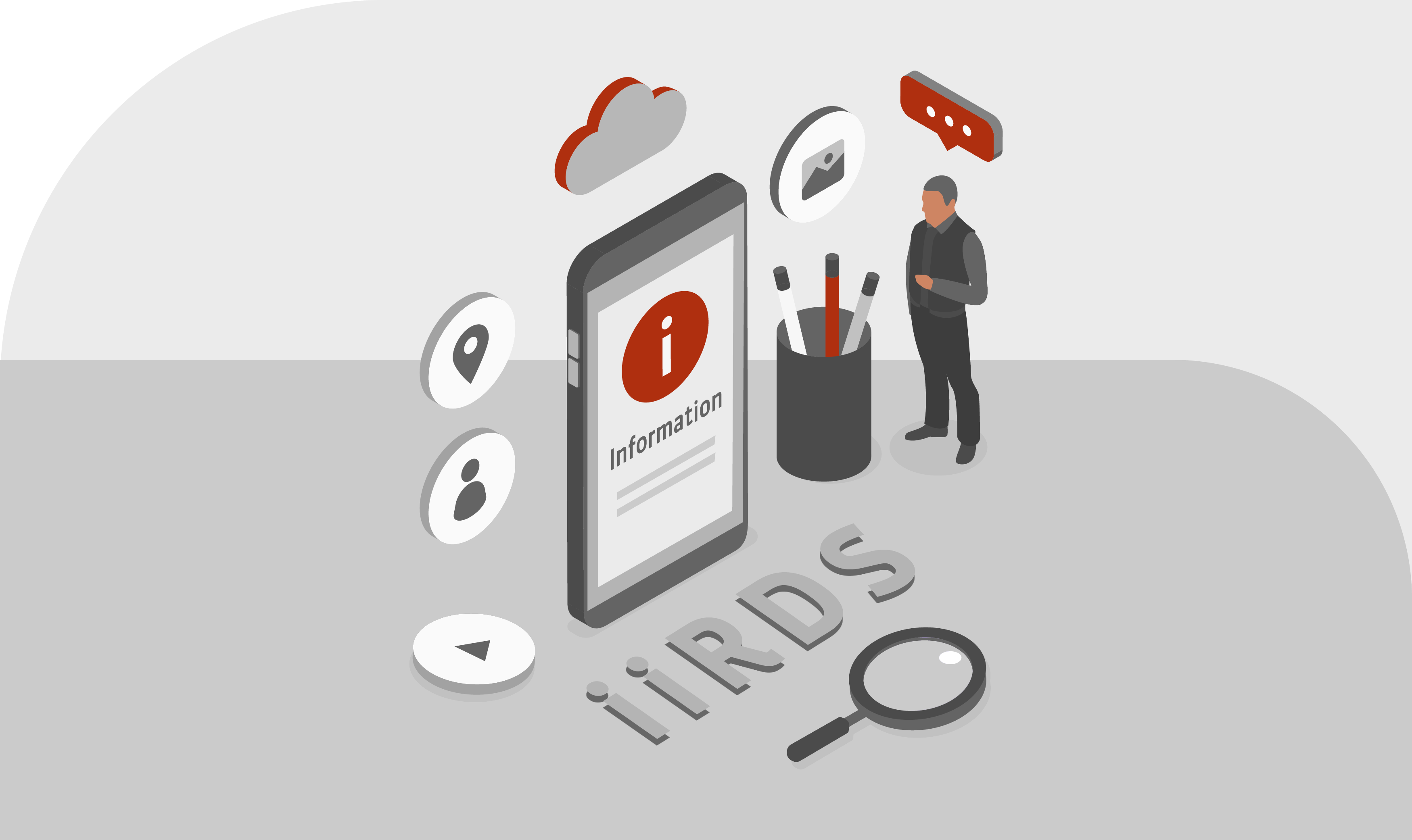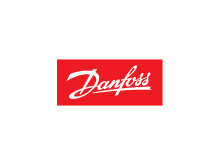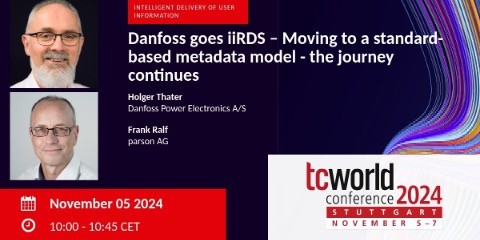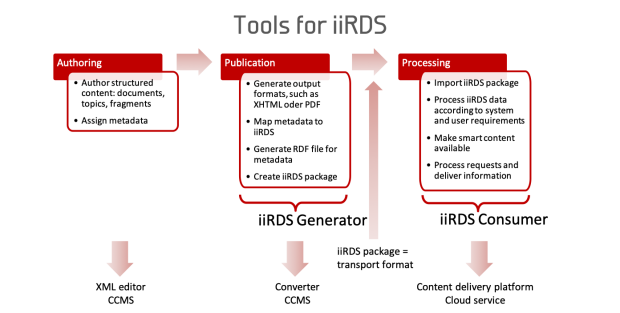Use iiRDS for digital technical documentation
Invest in smart content and the iiRDS standard
Focus your documentation on digitalization and Industry 4.0 and incorporate iiRDS.
iiRDS is the standard for the digital delivery of technical documentation as intelligent information. With intelligent information (smart content), you can provide users with granular and digital information instead of traditional manuals and give them exactly the information they need for a specific task in a particular situation. Content delivery portals, self-service portals, VR applications, and chatbots can use and deliver smart content.
The iiRDS standard is maintained by the iiRDS consortium. parson is a founding member of the iiRDS consortium.

Why introduce iiRDS? It is ideal for the Industrial Internet of Things!
Intelligent information means moving away from traditional, static documents. It is digitally accessible and can be presented depending on the context, for example, when maintenance is required or an error occurs in a smart factory. Rather than displaying an entire manual, the relevant information is delivered when and where it is needed. This way, digital products are effectively supported by information.
Trust in our knowledge and experience with the iiRDS standard. From the beginning, parson has played a leading role in its development and documentation. This is how we work.
Your contacts
Smart content and iiRDS
Introduce iiRDS and use smart content in a structured way. This is how we work
- Analyze your documentation: We assess whether your technical documentation and product information is ready for smart content.
- Develop a roadmap: Together, we develop a roadmap of the steps required to implement smart content based on iiRDS.
- Develop a metadata concept: We work with you to develop an iiRDS metadata approach and help you deliver iiRDS-compliant content, for example, from your CCMS.
- Delivery to touchpoints: We support you in integrating smart content in applications, such as content delivery portals or chatbots.
- Training: We train your technical communicators and subject matter experts in iiRDS.
Learn more about iiRDS in our FAQs.
FAQs – Frequently asked questions about iiRDS
What is iiRDS?
iiRDS stands for intelligent information Request and Delivery Standard. It is a standard for delivering technical documentation and other types of information as smart content. Intelligent information is defined as modular, metadata-enriched content that can be searched, filtered, and displayed by applications such as portals or mobile applications. iiRDS defines a metadata vocabulary for technical communication and a package format for delivering content.
Learn more about iiRDS about smart content and how iiRDS supports smart content delivery in our knowledge base article Intelligent delivery.
Where do I find the latest version of iiRDS?
You can download the latest version of the iiRDS standard at www.iirds.org under Materials. You must register first.
What are the advantages and benefits of iiRDS in technical documentation?
While intelligent information can be implemented without iiRDS, there are significant advantages to using and established standard like iiRDS. The standard is built with expert knowledge, supported by a variety of tools, and constantly evolving. By adopting iiRDS for your company's technical documentation and product information, you can leverage standardized metadata and generate output formats that are widely compatible.
What is iiRDS metadata?
The iiRDS metadata is based on Prof. Ziegler's PI Classification (PI Class®), which is the basis for content classification with metadata in established CCMS. Content tagged with iiRDS metadata is semantic, meaning it contains information about the type of content, product variant, or target audience. This allows it to be accurately displayed and interpreted by applications such as machine consoles, chatbots, or web portals.
What is included in the iiRDS specification?
Similar to the standard itself, the iiRDS specification is available free of charge upon registering on the iiRDS website. Here is the link to version 1.2. The specification details the iiRDS package format, metadata structure, and content and media file delivery format. It also contains a comprehensive schema reference of the metadata structures.
Which companies and industries are using iiRDS?
iiRDS is designed for cross-industry use. To facilitate customization for specific industries, iiRDS comes with built-in extension options and specialized metadata domains: one tailored for mechanical engineering and another for the software industry.
Several European companies are already using iiRDS or are working to implement the standard. Prominent examples include Siemens, Danfoss, SMA, and Zeiss. For more information, see the Best Practices on the iRDS website. See also videos about the use of iiRDS in companies on our YouTube channel.
Are there any iiRDS training programs?
- You can learn the basics of iiRDS online on our learning platform: "Introduction to iiRDS".
- Check out our YouTube channel – for example the recording of a webinar with Ulrike Parson: "Introduction to iiRDS".
- parson also offers advanced training courses on iiRDS. Contact us!
- The iiRDS consortium offers an online iiRDS training course.
Do I need a component content management system to use iiRDS?
No, you don't have to have a content management system. Basically, you require the following tools for iiRDS:
- Editing tool for creating structured content and assigning metadata. You can create structured content with iiRDS metadata in an (XML) editor within a content management system, but also without a content management system, e.g. in DITA with oXygen.
- iiRDS Generator to transform the content and metadata into the iiRDS format. An iiRDS generator creates valid iiRDS packages from the structured content. Such a generator may already be included in a content management system as a publication pipeline or be programmed as an extension of the corresponding authoring environment. For legacy documents, e.g. in PDF format, you can use converter tools from plusmeta or c-rex.net. In addition, the iiRDS consortium released an iiRDS converter for DITA.
- iiRDS consumer, that is a platform or service that receives the iiRDS packages and makes them available to users. To make the smart content contained in the iiRDS packages available in applications or portals, an iiRDS consumer must process the packages. iiRDS consumers can be, for example, content delivery platforms, web portals, and chatbot backends. The iiRDS consumers import intelligent information into their database and then make it available for search and information retrieval.
Is the iiRDS standard compatible with other standards?
The iiRDS standard is built on semantic web standards, including RDF, making it easy to integrate iiRDS metadata with metadata from other domains, such as product information or maintenance data. In addition, version 1.1 of the iiRDS standard includes an extension that facilitates compatibility with the ECLASS standard.
How does iiRDS relate to the VDI 2770 guideline??
Version 1.1 of iiRDS is harmonized with the VDI 2770 standard. There is also an implementation guide for iiRDS and VDI 2770. The guide contains the rules for creating hybrid packages that comply with both VDI 2770 and iiRDS. You can purchase the guide as a tekom publication.
Watch the video: Dr. Jan Oevermann (plusmeta) and Mark Schubert (parson) explain how hybrid packages work (from tcworld conference 2020): "Torte und Waffeln. Das Hybrid-Paket für iiRDS und VDI 2770" (in German).
For more questions and answers, see our blog post "iiRDS: We answer your questions".









